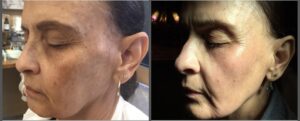 Melasma, also known as chloasma, is a condition that causes uneven skin coloration. It occurs when there is an excess of skin pigmentation due to the overproduction of melanin by melanocytes, the cells responsible for producing melanin.
Melasma, also known as chloasma, is a condition that causes uneven skin coloration. It occurs when there is an excess of skin pigmentation due to the overproduction of melanin by melanocytes, the cells responsible for producing melanin.
There are several factors that can contribute to the development of melasma, including exposure to ultraviolet light, genetic predisposition, and hormonal imbalances. Interestingly, the blue light emitted from LED screens, such as those found on cell phones, televisions, and laptops, can also play a role in the formation of melasma.
Melasma tends to appear on areas of the skin that are frequently exposed to the sun, such as the forehead, nose, cheeks, upper lip, chin, neck, arms, and back.
How is Melasma Diagnosed?
Diagnosing melasma can often be done by examining the discolored skin. In some cases, a Wood’s lamp, also known as a black light, can be used to determine the depth of the irregular pigmentation. This device can highlight differences in fluorescence within the skin pigment, making it easier to assess the extent of the condition.
Melasma can be classified into three types: dermal, epidermal, and mixed.
Dermal melasma does not have well-defined borders and may appear bluish or light brown. It does not differ in appearance under a black light and is the most challenging type to treat.
Epidermal melasma presents as dark brown patches with distinct edges and is easily visible under a black light.
Mixed melasma is the most common type and is characterized by a combination of brown and bluish colors. Its appearance under a black light shows a mixed pattern. Treatment options can vary depending on the type of melasma.
